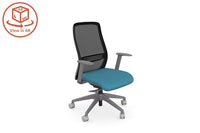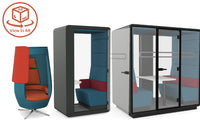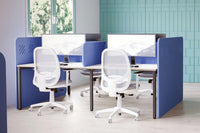The Essential Guide to Finding the Perfect Desk Chair for Your Office
Are you tired of sitting in an uncomfortable desk chair all day at work? It's time to find the perfect office chair that not only provides support and comfort but also complements your office decor. In this essential guide, we will walk you through the process of finding the ideal desk chair for your workspace.

With so many options available in the market, it can be overwhelming to choose the right chair. That's why we've done the research for you. Discover the factors to consider when selecting a desk chair, such as adjustability, lumbar support, and material. We will also explore different chair styles and designs, including ergonomic chairs, executive chairs, and mesh chairs, helping you make an informed decision.
Investing in a quality desk chair is essential for maintaining your posture, preventing back pain, and boosting productivity. So, whether you are setting up a home office or revamping your workplace, our comprehensive guide will ensure you find the perfect desk chair that ticks all the boxes.
Say goodbye to discomfort and hello to a chair you'll love sitting in all day. Let's dive in and find your perfect office companion!
Importance of a comfortable and ergonomic desk chair

A comfortable and ergonomic desk chair plays a vital role in maintaining your overall well-being and productivity in the workplace. Sitting for long hours can take a toll on your body, leading to various health issues such as back pain, neck strain, and poor posture. Investing in a quality desk chair is a wise decision that can help alleviate these problems and provide you with the necessary support and comfort throughout the day.
One of the key benefits of a comfortable desk chair is the improvement in your posture. A chair with proper lumbar support ensures that your spine maintains its natural curve, reducing the strain on your back. When your body is properly aligned, you are less likely to experience discomfort and fatigue, allowing you to focus on your work more effectively.
Furthermore, a well-designed desk chair promotes better blood circulation. Chairs with adjustable height and tilt mechanisms allow you to find the optimal position for your body, preventing any numbness or tingling sensations in your legs and feet. By improving blood flow, you can enhance your energy levels and concentration, ultimately boosting your productivity.
Lastly, a comfortable desk chair can also have a positive impact on your mental well-being. When you are physically comfortable, you are more likely to feel relaxed and less stressed. This can lead to a better mood and enhanced creativity, enabling you to perform your tasks with greater enthusiasm and efficiency.
Now that we understand the importance of a comfortable and ergonomic desk chair, let's delve into the factors you should consider when choosing the perfect chair for your office.
Factors to consider when choosing a desk chair
Choosing the right desk chair requires careful consideration of various factors. Here are the key aspects you should keep in mind to ensure you find a chair that suits your needs and preferences:
1. Adjustability
The adjustability of a desk chair is crucial for providing personalized support and comfort. Look for chairs that offer adjustable features such as seat height, armrest height, and seat depth. Being able to customize these settings allows you to find the perfect position that aligns with your body's natural curves and promotes good posture.
You can view all our chairs in 360 degree view
An adjustable lumbar support feature is also essential for maintaining the natural curve of your spine. This feature can help prevent lower back pain and provide additional support where you need it the most.
2. Lumbar support
Proper lumbar support is a key factor in determining the comfort and ergonomics of a desk chair. Look for chairs that have built-in lumbar support or adjustable lumbar pads. This feature helps to maintain the natural curvature of your spine, reducing the strain on your lower back.
When testing a chair for lumbar support, ensure that it fits snugly against the small of your back, providing adequate support without feeling uncomfortable or restricting your movement.
3. Material
The material of your desk chair not only affects its durability but also plays a role in its overall comfort. Common materials used for desk chairs include leather, fabric, and mesh.
Leather chairs are known for their luxurious appearance and durability. They are easy to clean and maintain, making them a popular choice for executive offices. However, leather chairs may not be as breathable as other materials, which can lead to discomfort in hot weather.
Fabric chairs are available in a wide range of colors and patterns, allowing you to match them with your office decor. They are generally more breathable than leather chairs, making them a suitable option if you work in a warmer environment. However, fabric chairs may require more maintenance and cleaning compared to leather chairs.
Mesh chairs have gained popularity in recent years due to their breathability and flexibility. The mesh material allows air to circulate, keeping you cool and comfortable throughout the day. Additionally, mesh chairs are lightweight and offer excellent support. However, they may not provide the same level of cushioning as leather or fabric chairs.
Consider your personal preferences, climate, and office environment when choosing the material for your desk chair.
Now that we've explored the key factors to consider when choosing a desk chair, let's move on to the different types of desk chairs available in the market.
When it comes to desk chairs, there is a wide variety of options available to suit different needs and preferences. Here are some of the most popular types of desk chairs:
1. Ergonomic Desk Office chairs
Ergonomic chairs are designed to provide optimal support and comfort for extended periods of sitting. These chairs are adjustable and feature various ergonomic features such as lumbar support, adjustable armrests, and seat depth adjustment. Ergonomic chairs are a great choice for individuals who spend long hours working at a desk, as they help reduce the risk of developing musculoskeletal disorders and promote good posture.
2. Executive Desk Office chairs
Executive chairs are known for their luxurious design and high-back support. These chairs are often made of leather and feature padded armrests and headrests. Executive chairs are commonly found in executive offices or home offices where style and comfort are equally important. They provide a professional and sophisticated look while ensuring ergonomic support.
Task chairs are designed for shorter periods of sitting and are commonly found in offices and workstations. These chairs are more basic in design compared to ergonomic or executive chairs but still offer comfort and adjustability. Task chairs typically have a smaller footprint and are suitable for individuals who engage in various tasks throughout the day, such as typing, writing, or attending meetings.
4. Gaming chairs
Gaming chairs are specifically designed for gamers who spend long hours in front of a computer or gaming console. These chairs feature a sporty design, with additional padding and support for the neck and back. Gaming chairs often come with adjustable features, such as reclining and rocking mechanisms, allowing gamers to find their ideal sitting position.
Understanding the different types of desk chairs can help you narrow down your options and choose the chair that best suits your needs. In the next section, we will explore ergonomic features in more detail and discuss their benefits.
Understanding ergonomic features and their benefits of office desk chairs

Ergonomic features play a crucial role in ensuring the comfort and support of a desk chair. Let's take a closer look at some of the common ergonomic features found in desk chairs and their benefits:
1. Adjustable seat height
Adjustable seat height allows you to customize the chair's height to match your desk or workstation. This feature ensures that your feet are flat on the floor and your knees are at a 90-degree angle, promoting good posture and reducing strain on your legs and lower back.
2. Adjustable armrests
Adjustable armrests provide support for your arms and shoulders, reducing the strain on your neck and upper body. The armrests should be positioned at a height that allows your shoulders to relax and your elbows to rest comfortably at a 90-degree angle.
3. Seat depth adjustment
Seat depth adjustment allows you to slide the seat forward or backward to ensure proper thigh support. When sitting, there should be a few inches of space between the edge of the seat and the back of your knees. This adjustment helps prevent pressure on the back of your thighs and promotes better circulation.
4. Tilt mechanism
A tilt mechanism allows you to recline the backrest of your chair. This feature helps you find a comfortable sitting position and reduces pressure on your lower back. Look for chairs with a multi-tilt mechanism that allows you to adjust both the seat and backrest independently.
5. Lumbar support
Proper lumbar support is essential for maintaining the natural curve of your spine and preventing lower back pain. Look for chairs with built-in lumbar support or adjustable lumbar pads. The lumbar support should fit snugly against the small of your back, providing adequate support and reducing strain on your lower back.
6. Headrest
A headrest provides support for your head and neck, reducing strain on your neck and upper back. If you spend long hours on the computer or engage in activities that require you to look up frequently, a chair with an adjustable headrest can help prevent neck pain and promote better posture.
By understanding the benefits of ergonomic features, you can make an informed decision when choosing a desk chair that promotes comfort and supports your overall well-being. In the next section, we will discuss how to properly adjust and set up your desk chair for maximum comfort and ergonomics.
How to properly adjust and set up your desk chair

Adjusting and setting up your desk chair correctly is essential to ensure maximum comfort and ergonomics. Here are the steps you should follow to properly adjust your chair:
1. Adjust the seat height
Start by adjusting the seat height so that your feet are flat on the floor and your knees are at a 90-degree angle. If your chair doesn't have adjustable height, consider using a footrest to achieve the correct position.
2. Set the seat depth
Adjust the seat depth so that there is a few inches of space between the edge of the seat and the back of your knees. This adjustment ensures proper thigh support and prevents pressure on the back of your thighs.
3. Position the lumbar support
Adjust the lumbar support to fit snugly against the small of your back. The support should be at a height that maintains the natural curve of your spine and provides adequate support without feeling uncomfortable or restrictive.
4. Adjust the armrests
Position the armrests at a height that allows your shoulders to relax and your elbows to rest comfortably at a 90-degree angle. The armrests should support your arms without causing strain on your neck or shoulders.
5. Set the backrest tilt
Adjust the backrest tilt to find a comfortable sitting position. The tilt should allow you to recline slightly while maintaining good posture. Experiment with different angles to find the position that feels most comfortable for you.
6. Consider additional adjustments
If your chair has adjustable headrests or other features, make sure to adjust them according to your preferences and needs. Experiment with different settings to find the optimal position for maximum comfort.
Remember to take breaks and stretch periodically, even with a properly adjusted chair. Regular movement and stretching are essential for maintaining good circulation and preventing muscle stiffness.
Now that you know how to properly adjust and set up your desk chair, let's move on to discussing the different materials used in desk chairs and their pros and cons.
Desk chair materials and their pros and cons
The material of your desk chair not only affects its durability but also plays a role in its overall comfort. Let's explore the common materials used in desk chairs and their pros and cons:
1. Leather
Leather chairs are known for their luxurious appearance and durability. They provide a sophisticated and professional look, making them a popular choice for executive offices. Leather is also easy to clean and maintain, as spills can be wiped off easily. However, leather chairs may not be as breathable as other materials, which can lead to discomfort in hot weather. Additionally, leather chairs tend to be more expensive compared to chairs made of other materials.
2. Fabric
Fabric chairs are available in a wide range of colors and patterns, allowing you to match them with your office decor. They are generally more breathable than leather chairs, making them a suitable option if you work in a warmer environment. Fabric chairs are also comfortable and offer good cushioning. However, fabric chairs may require more maintenance and cleaning compared to leather chairs, as stains can be more challenging to remove.
3. Mesh
Mesh chairs have gained popularity in recent years due to their breathability and flexibility. The mesh material allows air to circulate, keeping you cool and comfortable throughout the day. Mesh chairs are also lightweight and offer excellent support. However, they may not provide the same level of cushioning as leather or fabric chairs. Additionally, the mesh material may be less durable over time, especially if subjected to rough handling.
Consider your personal preferences, climate, and office environment when choosing the material for your desk chair. Each material has its own set of advantages and disadvantages, so choose the one that best suits your needs and requirements.









0 comments